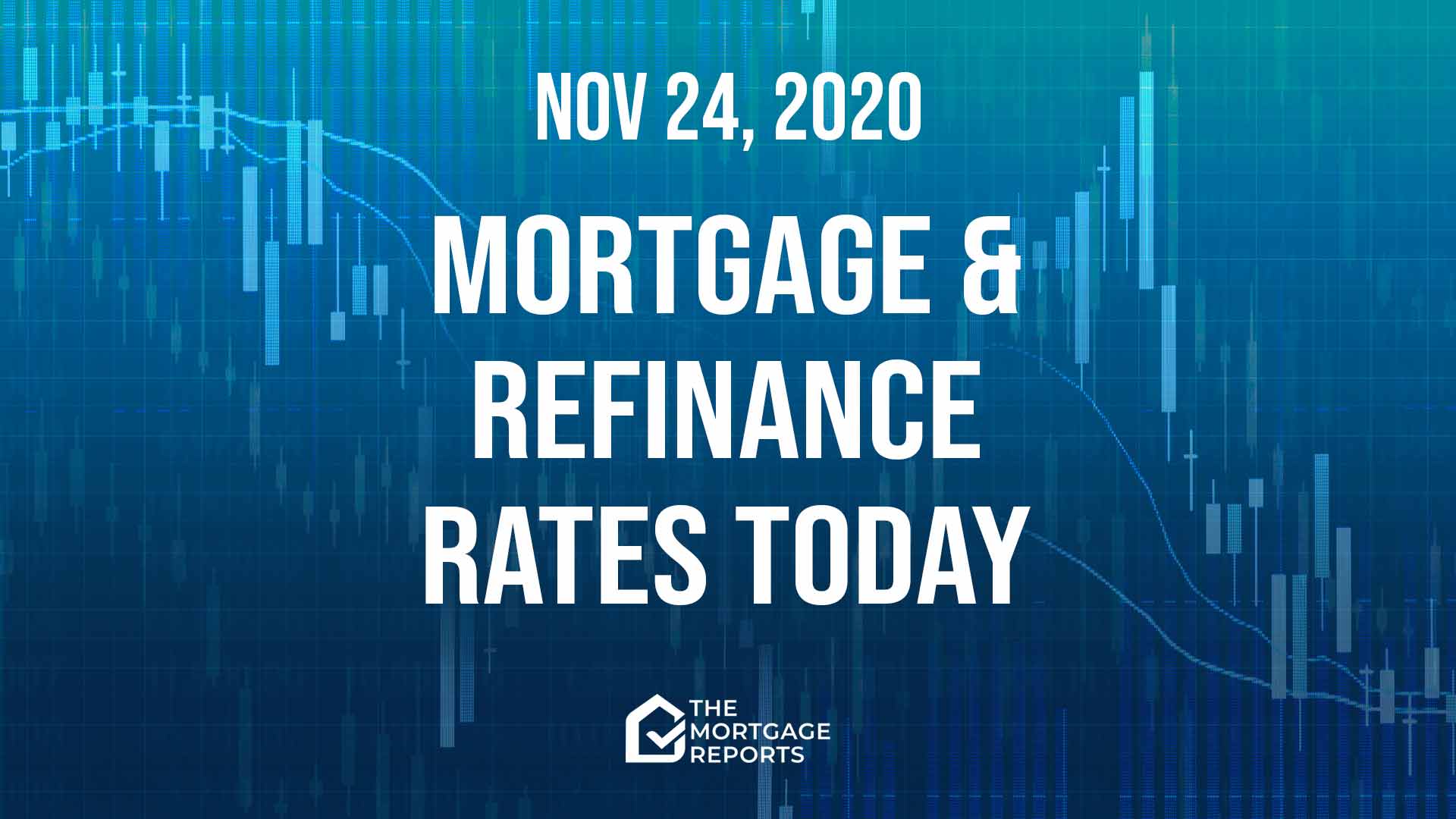
Today’s mortgage and refinance rates
Average mortgage rates edged a little higher yesterday, as we predicted. And conventional loans started out this morning at 3.063% (3.063% APR) for a 30-year, fixed-rate mortgage.
Unfortunately, we think another small rise is likely today. Markets are cheered by a triple whammy of good news: vaccine progress; the President-Elect’s transition; and the nomination of Janet Yellen as the next treasury secretary.
Find and lock a low rate (Nov 24th, 2020)Current mortgage and refinance rates
| Program | Mortgage Rate | APR* | Change |
|---|---|---|---|
| Conventional 30 year fixed | |||
| Conventional 30 year fixed | 3.063% | 3.063% | +0.06% |
| Conventional 15 year fixed | |||
| Conventional 15 year fixed | 3% | 3% | Unchanged |
| Conventional 5 year ARM | |||
| Conventional 5 year ARM | 3% | 2.743% | Unchanged |
| 30 year fixed FHA | |||
| 30 year fixed FHA | 2.938% | 3.919% | Unchanged |
| 15 year fixed FHA | |||
| 15 year fixed FHA | 2.125% | 3.065% | Unchanged |
| 5 year ARM FHA | |||
| 5 year ARM FHA | 2.5% | 3.226% | -0.01% |
| 30 year fixed VA | |||
| 30 year fixed VA | 2.875% | 3.053% | Unchanged |
| 15 year fixed VA | |||
| 15 year fixed VA | 2% | 2.319% | Unchanged |
| 5 year ARM VA | |||
| 5 year ARM VA | 2.5% | 2.406% | -0.01% |
| Rates are provided by our partner network, and may not reflect the market. Your rate might be different. Click here for a personalized rate quote. See our rate assumptions here. | |||
COVID-19 mortgage updates: Mortgage lenders are changing rates and rules due to COVID-19. To see the latest on how coronavirus could impact your home loan, click here.
Should you lock a mortgage rate today?
Nobody can predict for sure how long the current likely bump in mortgage rates is going to last. My instinct is that they’ll return to their previous pattern of continuing small falls (punctuated by brief rises) in a matter of days, maybe tomorrow.
So I wouldn’t lock today unless I were near to closing. And that’s because I suspect yet lower rates are in prospect, though probably not today.
See “Are mortgage and refinance rates rising or falling?” (below) for more. Meanwhile, my personal rate lock recommendations are:
- LOCK if closing in 7 days
- LOCK if closing in 15 days
- FLOAT if closing in 30 days
- FLOAT if closing in 45 days
- FLOAT if closing in 60 days
But with so much uncertainty at the moment, your instincts could easily turn out to be as good as mine — or better. So be guided by your gut and your personal tolerance for risk.
Market data affecting today’s mortgage rates
Here’s the state of play this morning at about 9:50 a.m. (ET). The data, compared with about the same time last Friday morning, were:
- The yield on 10-year Treasurys inched higher to 0.87% from 0.86%. (Bad for mortgage rates because it was falling after rises yesterday.) More than any other market, mortgage rates normally tend to follow these particular Treasury bond yields, though less so recently
- Major stock indexes were almost all higher on opening. (Bad for mortgage rates.) When investors are buying shares they’re often selling bonds, which pushes prices of those down and increases yields and mortgage rates. The opposite happens when indexes are lower
- Oil prices rose to $44.28 from $42.81 a barrel. (Bad for mortgage rates* because energy prices play a large role in creating inflation and also point to future economic activity.)
- Gold prices fell to $1,799 from $1,862 an ounce. (Bad for mortgage rates*.) In general, it’s better for rates when gold rises, and worse when gold falls. Gold tends to rise when investors worry about the economy. And worried investors tend to push rates lower
- CNN Business Fear & Greed index — Jumped to 84 from 75 out of 100. (Bad for mortgage rates.) “Greedy” investors push bond prices down (and interest rates up) as they leave the bond market and move into stocks, while “fearful” investors do the opposite. So lower readings are better than higher ones
Caveats about markets and rates
Before the pandemic and the Federal Reserve’s interventions in the mortgage market, you could look at the above figures and make a pretty good guess about what would happen to mortgage rates that day. But that’s no longer the case. The Fed is now a huge player and some days can overwhelm investor sentiment.
So use markets only as a rough guide. They have to be exceptionally strong (rates are likely to rise) or weak (they could fall) to rely on them. But, with that caveat, they’re looking a little worse for mortgage rates today.
Find and lock a low rate (Nov 24th, 2020)
Important notes on today’s mortgage rates
Here are some things you need to know:
- The Fed’s ongoing interventions in the mortgage market (way over $1 trillion) should put continuing downward pressure on these rates. But it can’t work miracles all the time. So expect short-term rises as well as falls. And read “For once, the Fed DOES affect mortgage rates. Here’s why” if you want to understand this aspect of what’s happening
- Typically, mortgage rates go up when the economy’s doing well and down when it’s in trouble. But there are exceptions. Read How mortgage rates are determined and why you should care
- Only “top-tier” borrowers (with stellar credit scores, big down payments and very healthy finances) get the ultralow mortgage rates you’ll see advertised
- Lenders vary. Yours may or may not follow the crowd when it comes to daily rate movements — though they all usually follow the wider trend over time
- When rate changes are small, some lenders will adjust closing costs and leave their rate cards the same
- Refinance rates are typically close to those for purchases. But some types of refinances from Fannie Mae and Freddie Mac are currently appreciably higher following a regulatory change
So there’s a lot going on here. And nobody can claim to know with certainty what’s going to happen to mortgage rates in coming hours, days, weeks or months.
Are mortgage and refinance rates rising or falling?
Today
I think mortgage rates are likely to rise slightly again today. That’s because of a happy coincidence (though not happy for those waiting to lock) of three pieces of good economic news over the last 30 hours:
- British pharmaceutical giant AstraZeneca revealed the results of trials of its COVID-19 vaccine — And it may be easier to scale up manufacturing capacity and to store and transport this one than others. It’s also likely to be cheaper
- Administrator of the General Services Administration Emily W. Murphy has given the green light to President-Elect Joe Biden to begin his transition to power, removing an element of uncertainty
- Mr. Biden has signaled that he will nominate former Federal Reserve Chair Janet Yellen as his treasury secretary. Markets like that she’s a safe pair of hands, and even more so that she’s not Sen. Elizabeth Warren, a candidate who’s too progressive for investors’ tastes
It’s unclear how long investors will be buoyed by this news. My gut feel (nothing more than that) is that it will be a matter of a day or days. And, once day-to-day reality intrudes, mortgage rates might resume their gentle downward movement. (But expect occasional periods of rises.)
That’s because that day-to-day reality remains grim, whoever occupies high offices. New coronavirus infections and deaths remain frighteningly high. And the outlook isn’t good: Global management consultancy McKinsey & Company updated its pandemic forecast in response to the latest vaccine news:
The positive readouts from the vaccine trials mean that the United States will most likely reach an epidemiological end to the pandemic (herd immunity) in Q3 or Q4 2021.
McKinsey & Company, When will the COVID-19 pandemic end?, Nov. 23, 2020
In other words, the pandemic is probably going nowhere for at least eight months and possibly 13. The economic implications of that cold fact may soon sober up overexuberant investors.
Recently
Over the last few months, the overall trend for mortgage rates has clearly been downward. A new all-time low was set during each of the weeks ending Oct. 15 and 22 and Nov. 5 and 19 according to Freddie Mac. Last Thursday’s record low was the 13th this year.
But note that Freddie’s figures relate to purchase mortgages alone and ignore refinances. And if you average out across both, rates have been consistently higher than the all-time low since a record set in August. The gap between the two has been widened by a controversial regulatory change.
Expert mortgage rate forecasts
Looking further ahead, Fannie Mae, Freddie Mac and the Mortgage Bankers Association (MBA) each has a team of economists dedicated to monitoring and forecasting what will happen to the economy, the housing sector and mortgage rates.
And here are their current rates forecasts for the last quarter of 2020 (Q4/20) and the first three of 2021 (Q1/21, Q2/21 and Q3/21).
But note that Fannie’s (released on Nov. 17) and the MBA’s (also Nov. 17) are updated monthly. However, Freddie’s are now published quarterly. And its latest was released on Oct. 14.
The numbers in the table below are for 30-year, fixed-rate mortgages:
| Forecaster | Q4/20 | Q1/21 | Q2/21 | Q3/21 |
| Fannie Mae | 2.8% | 2.8% | 2.8% | 2.8% |
| Freddie Mac | 3.0% | 3.0% | 3.0% | 3.0% |
| MBA | 2.9% | 3.0% | 3.0% | 3.2% |
So predictions vary considerably. You pays yer money …
Find your lowest rate today
Some lenders have been made nervous by the pandemic. And they’re restricting their offerings to just the most vanilla-flavored mortgages and refinances.
But others remain brave. And you can still probably find the cash-out refinance, investment mortgage or jumbo loan you want. You just have to shop around more widely.
But, of course, you should be comparison shopping widely, no matter what sort of mortgage you want. As federal regulator the Consumer Financial Protection Bureau says:
Verify your new rate (Nov 24th, 2020)Shopping around for your mortgage has the potential to lead to real savings. It may not sound like much, but saving even a quarter of a point in interest on your mortgage saves you thousands of dollars over the life of your loan.



